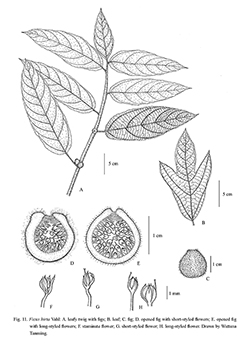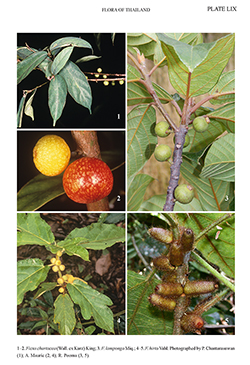e-Flora of Thailand
Volume 10 > Part 4 > Year 2011 > Page 519 > Moraceae > Ficus
FIC10. Ficus hirta Vahlwfo-0000688681
Enum. Pl. 2: 201. 1805; Blume, Bijdr. Fl. Ned. Ind.: 476. 1825; Miq., Ann. Mus. Bot. Lugd.-Bat. 3: 290. 1867; Kurz, Forest Fl. Burma 2: 449. 1877; King, Ann. Roy. Bot. Gard. (Calcutta) 1(2): 149, t. 188. 1888; Gagnep., Fl. Indo-Chine 5: 804. 1928; Chun, Sunyatsenia 1: 225. 1934; C.C.Berg & Corner, Fl. Males., Ser. 1, Spermat. 17(2): 113. 2005; C.C.Berg, Thai Forest Bull. (Bot.) 35: 21. 2007. Fig. 11. Plate LIX: 4–5.
Accepted Name : Ficus simplicissima Lour.
Fl. Cochinch.: 667. 1790.
Synonyms & Citations :
Description : Shrub or treelet to 5 m tall. Leafy twigs 2–4 mm thick, whitish to dark brown puberulous to hirtellous and pale brown to yellowish hirtellous, subhirsute or dark brown hirsute (or strigillose), the long hairs often with a swollen base; waxy glands sometimes present at the base of the petiole; internodes sometimes hollow; periderm persistent. Leaves in spirals (to subdistichous); lamina oblong, elliptic, (sub)obovate, (sub)ovate or lanceolate, often with a constriction in the lower part of the lamina, or (when juvenile) (sub)palmately 3–5–7-lobate to -fid or pinnately lobate or the mid-segment sometimes pinnately lobate, 6–25 by 3.5–16 cm, chartaceous to subcoriaceous, apex (shortly) acuminate, base cordate to rounded, margin dent(icul)ate; upper surface strigillose, hirtellous or hirsute, scabrous to smooth, lower surface densely to rather sparsely whitish puberulous and pale to dark brown hirtellous, substrigose or hirsute on the veins, often scabridulous; cystoliths absent; lateral veins (5–)6–8 pairs, the basal pair to ⅙–⅓ the length of the entire lamina, in lobate ones to ½, usually branched, other lateral veins often branched or forked away from the margin, tertiary venation scalariform, ± prominent beneath; waxy glands in the axils of the basal lateral veins and often small ones in the axils of other lateral veins; petiole 1.5–4(–12.5) cm long, 1–2 mm thick, whitish puberulous or pale to dark brown hirtellous or hirsute, the epidermis persistent; stipules 0.5–2 cm long, ciliolate and with stiff appressed to ± patent pale to dark brown hairs on or also along the keel or also finely white appressed-puberulous to sericeous towards the margins, or sometimes the whole surface yellow to brown sericeous to subhirsute, caducous (or subpersistent). Figs axillary or just below the leaves, in pairs or solitary, (sub)sessile; basal bracts 3, 2–3 mm long, brownish to whitish appressed-puberulous to strigillose, persistently on the keel or on the whole surface; receptacle subglobose, ovoid or ellipsoid (to (sub)cylindrical), 0.4–1.2 cm diam. when dry, 1–2 cm diam. when fresh, densely to sparsely pale to dark brown hirtellous, puberulous, hispidulous or subhirsute (or subglabrous), sometimes with lateral bracts, yellow to orange or (dark) red at maturity, apex ± convex, ostiole 2–3(–3.5) diam., surrounded by to 2 mm long bracts or with a tuft of hairs pointing upwards or the ostiole slightly impressed; internal hairs abundant to sparse, whitish.
Thailand : NORTHERN: Chiang Mai, Chiang Rai, Nan, Lamphun, Lampang, Tak, Phitsanulok; NORTH-EASTERN: Phetchabun, Loei, Nong Khai, Sakon Nakhon; EASTERN: Chaiyaphum, Nakhon Ratchasima, Si Sa Ket; SOUTH-WESTERN: Kanchanaburi; CENTRAL: Nakhon Nayok; SOUTH-EASTERN: Prachin Buri, Chachoengsao, Chon Buri, Chanthaburi, Trat; PENINSULAR: Phuket, Satun, Yala.
Distribution : NE India, Nepal, Sikkim, S China (type), Burma, Laos, Vietnam, Indonesia (Java, Sumatra, introduced).
Ecology : Mixed deciduous, dry evergreen and evergreen forests, often in secondary growths or disturbed areas, to 1,300 m alt.
Vernacular : Manot nam (มะนอดน้ำ)(Chiang Rai); salot nam (สลอดน้ำ)(Central); duea khon (เดื่อขน)(Northern); duea hom lek (เดื่อหอมเล็ก), duea hom yai (เดื่อหอมใหญ่)(Trat); nom ma (นมหมา)(Nakhon Phanom); not nam (นอดน้ำ)(Lampang); not hom (นอดหอม), ma duea tia (มะเดื่อเตี้ย)(Chanthaburi); ma duea khon (มะเดื่อขน)(Nakhon Ratchasima); ma duea hom (มะเดื่อหอม)(Chon Buri, Trang); yuea-thong (เยื่อทง)(Yao-Chiang Rai); hat (หาด)(Chiang Mai).
Notes: This species is extremely variable in the shape and dimensions of the lamina, the length of the peduncle, the shape and the dimensions of the receptacle, and the indumentum (colour, length, and rigidity of the hairs and denseness of the two types of hairs). The hairs vary from brown to white, from long (hirsute) to short (hispidulous), from straight to curved (or even uncinate), and from dense to very sparse. Rather distinct among specimens with dense brown indumentum on leafy twigs, petioles and venation of the lamina beneath are some collections from Laos and the adjacent part of Thailand with appressed hairs, and because of that (almost) smooth upper surfaces of the lamina. They were included in Ficus hirta var. appressa Corner, known from Thailand by three collections: Larsen et al. 43518 -BKF P from Nan, Parinya et al. 227 -BK from Uttaradit, and Srisanga 301 -QBG from Nan. More complex is the situation with regard to specimens with (very) short, (very) sparse, predominantly whitish indumentum. They occur more scattered in the range of distribution of the species and intermediates with the more distinctly hairy forms are frequent. They include type material of F. dumosa, F. hirta var. imberbis, F. palmatiloba, F. tridactytes, and probably even of F. simplicissima, characterized by the presence of uncinate hairs. Deeply incised, 3–5(–7) partite laminas may occur more frequently in this group of specimens than in those with more common types of indumentum. This form is not as common in Thailand as in Vietnam. It could be identified as F. hirta Vahl var. imberbis Gagnep. to distinguish it from var. appressa and the variable remainder. The last set of species names is not included in the synonymy as further investigations are needed.


